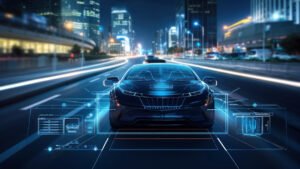Hybrid cars are becoming increasingly popular in the automotive industry because they are more environmentally friendly than regular gasoline cars. Hybrid vehicles combine the best features of an internal combustion engine (ICE) and an electric motor. It provides a balance between speed and fuel consumption. This technology helps reduce pollution, improve fuel economy, and make driving more comfortable. To fully understand how hybrid vehicle technology will change the way we travel in the future, you need to understand how it works.
1. The Basic Concept of Hybrid Vehicles
A hybrid car uses two power sources together: a combustion engine and an electric motor. Fully electric vehicles (EVs) get their energy exclusively from batteries. Hybrid cars, on the other hand, use both an internal combustion engine and an electric motor to propel the car. The electric motor can support the gasoline engine in certain driving situations, such as when the car is driving slowly or quickly. This makes the engine work easier and saves fuel.
The most important thing about hybrid cars is that they can switch between a gas engine and an electric motor without any problems. Hybrid vehicles offer the best of both worlds, as they have the range and power of a regular car with the fuel efficiency of an electric motor.
2. How do Hybrid Cars Work?
Hybrid cars operate by switching or combining electric and petrol engines, depending on road conditions. Many hybrid cars use their electric motors to drive at low speeds, such as when the car is idling or in stop-and-start traffic. During these times, the petrol engine remains switched off, which helps reduce fuel consumption and pollution.
When more power is needed, such as for acceleration or pick-up, the petrol engine is switched on to provide power. Sometimes petrol engines and electric motors work together for the best results. Regenerative braking recovers energy when the car slows down or stops. Kinetic energy is converted into electrical energy to charge the battery.
3. The Role of Regenerative Braking
Regenerative braking is one of the most important developments in hybrid vehicles, as it makes them more efficient. When the driver brakes, the hybrid system absorbs that energy and stores it in the car’s battery, instead of wasting it as heat. The electric motor switches roles and becomes a generator, converting the kinetic energy into electrical energy while stationary.
This process helps charge the battery, so it doesn’t have to rely on a gasoline engine or other power source. Regenerative braking is an important part of hybrid vehicles because it not only saves fuel but also keeps the brakes in better condition.
4. Battery Technology for Hybrid Vehicles
The battery in a hybrid car is an important part because it saves the electricity needed to run the electric motor. Most hybrid cars use lithium-ion or nickel-metal hydride batteries, which can store large amounts of energy and charge quickly. Although these batteries aren’t as large as those in pure electric cars, they’re still powerful enough to support the gasoline engine and, in some cases, power the car for short periods on its own.
Speed and battery life are very important in hybrid technology. New hybrid vehicles are equipped with intelligent battery management systems that monitor battery health, charge level, and energy usage. This ensures that the battery stays in optimal condition throughout the life of the car, providing power when needed, and reducing wear and tear.
5. Benefits of Hybrid Cars
Hybrid vehicles have many great features and are a great choice for drivers who care about the environment and want to save money on gas.
Better Gas Mileage: Hybrids use much less gas because they have an electric motor to assist the gas engine. This is especially true in cities with heavy traffic. In the long run, this means lower fuel costs.
Fewer Pollutants: Because hybrid cars use electricity for some activities, they produce fewer greenhouse gases than cars that run on gas alone. This makes hybrid cars better for the planet because they help clean the air and leave a smaller carbon footprint.
Lower Maintenance Costs: The internal combustion engine in a hybrid car generally wears out more slowly because the electric motor shares the work. In addition, regenerative braking prevents brake components from wearing out quickly, meaning the car requires less maintenance over its lifetime.
Better noise levels: Hybrid cars are generally quieter than regular cars, especially when driving slowly and using only electric power. At the same time, this makes driving more comfortable and quiet.
6. The Future of Hybrid Vehicle Technology
As the auto industry continues to change, hybrid vehicles will be a major part of the movement toward cleaner, greener transportation. Improvements in battery technology, electric motors, and energy management systems will make hybrid vehicles more fuel efficient, faster, and a better choice for drivers.
In addition, government regulations aimed at reducing pollution and encouraging cleaner cars could lead to greater advancements in hybrid technology. Many automakers have invested heavily in the development of hybrid and electric vehicles. This means that hybrid vehicles will remain a major part of the auto industry for many years to come.
Conclusion
Hybrid vehicle technology is a major step forward for the auto industry when it comes to reducing emissions and improving fuel economy. Hybrid vehicles are a great way for drivers to help the environment without sacrificing range or speed, as they combine the best features of both electric and gasoline vehicles. As technology continues to develop, hybrid vehicles can become more fuel-efficient and less expensive, making them an important part of the future of transportation.
FAQs
1. What is a hybrid car?
Hybrid vehicles have both an internal combustion engine (ICE) and an electric motor. This allows the car to use less fuel and produce less pollution. Depending on the driving conditions, it can run on either or both sources of power.
2. How does a hybrid car switch between fuel and electricity?
Hybrid cars naturally switch between electric and gas, depending on how the driver is driving the car. At low speeds, the electric motor usually powers the car. When speed increases or the car needs to accelerate, the combustion engine takes over.
3. What are the benefits of electric cars?
Hybrid cars are more fuel-efficient, cleaner, less expensive to maintain, and quieter, making them a good choice. They are better for the planet than regular gasoline-powered cars.
4. What does regenerative braking mean?
Regenerative braking is a method of converting the energy lost when a car brakes into electrical energy, which is then stored in the battery. This makes the system work better and prevents wear and tear on brake components.
5. How long do hybrid car batteries last?
Hybrid car batteries have a long lifespan. Depending on how they are used and driven, they can last 8 to 10 years or more. Most companies that make hybrid batteries offer long-term warranties.



